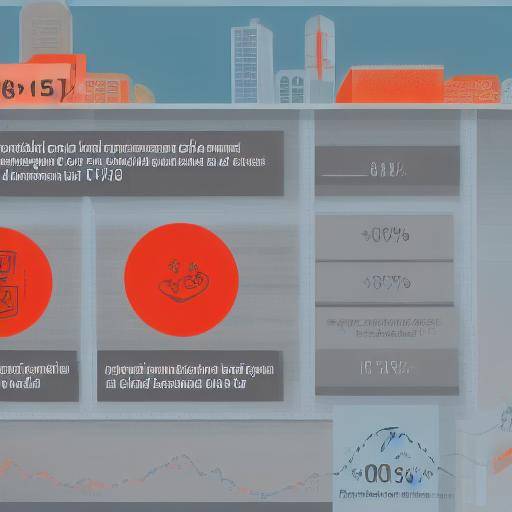
Introduction
Financial health is a vital aspect for individuals, families, businesses and the economy in general. It is essential to understand key indicators that allow us to evaluate, diagnose and maintain financial stability. In this article, we will thoroughly explore these fundamental aspects and provide valuable information to improve the understanding of financial health. From the assessment of the current situation to the diagnosis and strategies for maintaining financial stability, we will analyse best practices, current trends and future predictions. This knowledge is essential to making informed decisions and ensuring a solid financial future.
Financial Health Assessment
Financial health assessment is the first step in understanding the current situation. It consists of analysing income, expenses, debts, assets and liabilities. It is crucial to assess the relationship between these elements to obtain a clear picture of financial health. This evaluation can be done through the creation of a detailed budget that shows all cash flows and financial obligations. The calculation of net assets also provides an overview of personal or business financial health.
It is important to mention that the evaluation is not only based on numbers, but also on the emotional and psychological stability associated with finance. Cost habits, financial knowledge and risk management are critical factors that should be considered during evaluation.
Financial Diagnosis: Identifying Strengths and Improvement Areas
Once the evaluation is done, it is vital to conduct a detailed financial diagnosis. This step involves identifying the strengths and weaknesses of the financial situation. Are you spending more than you earn? Do debts exceed assets? Are there profitable investments or are there losing opportunities for growth?
In making a financial diagnosis, it is essential to analyze trends over time. Have there been improvements or declines in financial health? This analysis provides valuable information on past financial decisions and how the current situation affects. In addition, by identifying areas of improvement, strategies can be implemented to optimize long-term financial health.
Maintain Financial Stability
Financial stability is the result of informed and sustainable decisions based on evaluation and diagnosis. It implies the ability to maintain a balance between income and expenditure, manage debts responsibly and create a financial mattress to face unforeseen.
Income diversification, investment in profitable assets, regular savings and efficient resource management are key pillars for maintaining financial stability. In addition, financial education plays a crucial role in empowering people to make informed decisions and avoid financial traps.
Expanding the Financial Health Concept
Importance of Financial Education
Financial education is an essential component for improving financial health. It allows individuals to better understand the concepts of investment, savings, debt management and financial planning. Continuous education on these topics trains people to make more informed decisions and avoid common mistakes that can negatively affect their finances.
Technology Role in Financial Management
Technology has transformed the way we handle our finances. Financial management applications, cost tracking tools and online investment platforms facilitate monitoring and control of financial resources. Adopting these tools can significantly improve efficiency and accuracy in personal and business financial management.
Income Diversification Strategies
Diversifying income sources is an effective strategy for improving financial health. Investing in various assets, undertaking secondary activities and exploring new business opportunities are ways to reduce dependence on a single source of income, providing greater security and financial stability.
Conclusion
Understanding key indicators of good financial health is essential to ensuring a sound financial future. In assessing, diagnosing and maintaining financial stability, informed decisions that boost growth and prosperity can be made. It should be remembered that financial health is not only about numbers, but also about habits, knowledge and emotions related to money. In applying the knowledge gained, a stable and prosperous financial path can be ensured.
Frequently asked questions
1. What are the key indicators of good financial health?
Key indicators include net assets, income, expenditure, debts, assets and liabilities. In addition, emotional stability and risk management are also important factors.
2. How can I improve my financial health if I have significant debts?
It is crucial to develop a structured payment plan, reduce non-essential costs and consider alternatives such as debt consolidation or renegotiation of interest rates.
3. What is the importance of income diversification to maintain financial stability?
Income diversification is crucial to reducing dependence on a single source of income, which provides stability in unforeseen economic situations. This can be achieved through investments, secondary enterprises or sources of passive income.
4. How can I maintain an effective budget to ensure financial stability?
It is essential to record all income and expenditure, to establish clear limits for different categories of expenditure and to regularly review the performance of the budget. Savings and payments automation can also be useful.
5. What impact does financial education have on general financial health?
Financial education allows people to acquire knowledge about money management, investment, savings and risk management, which enables them to make informed financial decisions and avoid financial traps.
6. What are some strategies to maintain long-term financial stability?
In addition to income diversification and cost-efficient management, it is essential to have an emergency fund, invest in long-term solid assets and acquire continuous knowledge on personal finance and investments to adapt to changes in the financial environment.
These FAQs provide valuable information on how to evaluate, diagnose and maintain financial stability. By understanding these key concepts, you can take control of personal or business finances and ensure a prosperous financial future.
By combining knowledge on evaluation, diagnosis and financial stability, a sound basis for informed financial decision-making is established. This article provides a comprehensive guide to understanding and applying these concepts, ensuring the creation of sound and sustainable financial habits for the future.






















































